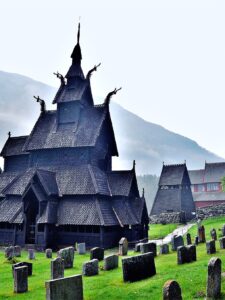
One of the most recognized examples of Norwegian history and culture is the stave church (“stavkirke”). Unique to Norway, they are medieval yet elegant symbols of Christianity’s initial foothold into a country whose Viking era and ancient gods were a recent memory. Architecturally the stave churches are quite impressive. Made only of wood, some of them have survived for as many as 800 years.
Most of the stave churches were built before 1350, when the Black Death ravaged the country, and the first of them did not survive because the timbers of the walls were set directly into the ground where they quickly rotted. Eventually the corner posts (staves) and wall planks were set on beams or sills of stone above the ground. Their structure of columns, planks, and supports were joined by dovetailing, pegs, and wedges, never by glue or nails. They were therefore completely flexible and could easily expand and contract depending on the weather. From Norway’s Stave Churches (out of print) by Eva Valebrokk and Thomas Thiis-Evensen is this description of a church weathering a storm:
“In the Afternoon the Weather changed, and suddenly an entire storm raged outside. It creaked in the old church Walls, as if they were going to fall apart, it was as if each and every plank in the stave construction would slide out of its Placement, break its very framework of Masts and Sills and bury everything beneath the vacillating Columns… but little by little the raging wind blew more fitfully, became constant…although the storm increased rather than declined, soon no sound was to be heard in the Church Walls, wherein the entire Structure had settled and was now steeled and strengthened in the midst of the storm.”
An illustration and description of the construction of a stave church:
“The raft beams were first placed on the foundation of stones. They intersect one another at the corners and continue outward to support any adjacent galleries or transepts. The tall staves which framed the nave were inserted into the mortised raft beams and joined on top by a new square section of beams. This supported the sharply pitched triangular roof trusses. These again supported the roof and the bell tower which straddled the ridge of the roof.
At this point the structure still needed added support to prevent it from collapsing in the wind. First, a continuous “belt”of cross braces followed the periphery of the room. Also, there were arches inserted between the staves in the form of curved wooden brackets. Lastly, the low aisle section resting on the raft beams protruding from the nave was also very critical to the structural support of the church.”
– (Lorentz Dietrichson)

There were once hundreds, perhaps even thousands, of stave churches across Norway. Between 1650 and 1850 their numbers were reduced from 270 to 60. Then, in 1851 a new law in Norway stated that rural churches must have seating for at least three-tenths of the parishioners. Many did not survive.
Even in modern times the churches have taken a beating. Since 1992, 22 churches have been destroyed by arson (most have been rebuilt), including the Holmenkollen Chapel, where the late King Olav V and his family had attended, and the Fantoft stave church just outside of Bergen. Almost all the burnings have been attributed to a small but zealous group of Satanist-nationalists and their followers. Today, 28 stave churches remain.
Some examples of stave churches in Norway:

The Borgund stave church in Laerdal in Sogn is considered the best preserved of the surviving stave churches and is thought to have been built in the last decades of the 12th century. Learn more.
Another beautiful example of stave church construction is the Urnes stave church in Luster in Sogn. It sits 120 meters above the sea with a magnificent view over the Sognefjord. The oldest decorations in the Urnes church, including the main portal and two gable sections, were originally from an older church, whose traces were found in the excavation under the currently standing structure. This unique ornamentation has become known as the “Urnes Style.” Learn more.
Even in the United States there are stave churches! Between 1968 and 1969 a replica of the Borgund stave church (Laerdal, Norway) was built in Rapid City, South Dakota. More recently, a replica of the Hopperstad stave church (Vik, Norway) was built in Hjemkomst Center in Moorhead, Minnesota.
